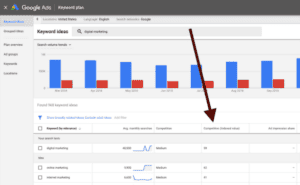If you’re a marketer, naturally, you have your eyes on high-competition keywords. Ranking for these competitive keywords translates to improved organic traffic for your website.
However, achieving this rewarding outcome requires careful steps to identify, analyze, and incorporate them into your content.
Success hinges on regularly updating your SEO strategy, placing keywords strategically, and ensuring full-fledged on-page optimization.
Feeling overwhelmed? Don’t worry!
In this blog post, we’ll discuss everything you need about competition keywords, including keyword research, competitor research, tools, and more.
Table of Contents
Understanding Competition Keywords
Competition keywords are fundamental to understanding the intricacies of a successful SEO strategy. Ranking in the digital space and scaling a business can be more manageable if you have a solid grasp of keyword research.
These keywords are the terms and phrases strategically used and targeted by your competitors to shape a sound SEO strategy.
Unlike generic keywords, competition keywords reveal what’s working and what’s not. Observing what benefits your competitors can give you an edge in developing your strategy for a successful SEO campaign.
However, understanding competitive keywords is not just about recognizing which terms to use in your content. It provides deeper insights into their prominence within the broader digital landscape.
You can match and even exceed current SEO standards by analyzing their keyword usage on specific pages, predicting your usage, and refining your content.
Why Conduct Keyword Research?
- The foundation of SEO strategy: Keywords are the backbone of an effective Search Engine Optimization strategy. Keywords ensure that your content attracts organic traffic through search queries to your website.
- Understanding customer language: When you research a particular keyword or keyphrase, you get the search query and the language in which the query is made. Adjusting your content language according to the search query can greatly benefit your website’s performance.
- Visibility boost: Incorporating high-volume keywords in your content can lead to a visibility boost of your website on the search engine result page. Consequently, this drives higher traffic to your site.
- Targeting niche audiences: Targeting a niche audience results in better organic traffic than writing for a wider audience. Keyword research lets you list primary keywords, keyword variations, long-tail keywords, and intent-based keywords, allowing you to foster higher conversion rates and meaningful interactions.
- Competitive edge: This was the major point of conducting keyword research, which is to gain a competitive edge against your rivals. Incorporating the competition keywords in your content, identifying the gap, and trying different variations can help you lead the competitive landscape.
- Optimizing on-page and off-page elements: Keywords form the basis of an actionable on/off-page optimization. Strategic placement of these keywords in the meta tags, headers, content, anchor texts, backlinks, and social media profiles can enhance your relevance and boost the overall ranking of your page.
Read also: A Complete eCommerce SEO Guide for Beginners
How to Identify Your Competitors
The first step towards developing a successful SEO strategy is the identification of competitors.
Recognizing your competitor in the industry can help you watch for market trends, success stories, and ways to beat them at their own game.
Analyze the market
The market can be analyzed from two standpoints: direct and indirect competitors. Direct competitors have business operations similar to yours and operate within your industry.
On the other hand, indirect competitors don’t necessarily operate in your domain, but their strategies can benefit your online traffic in less apparent ways.
The best approach for competitor analysis is to explore online spaces where your competitors discuss their work. This could be their website, industry forums, social media, or other relevant publications. By doing so, you equip yourself with valuable information that will give you leverage in the competitive landscape.
By interpreting and analyzing your competitors, you can develop informed strategies, knowing what to do and what to avoid, ultimately improving your website’s performance.
Tools & resources
Streamlining your SEO strategy down to the keyword level requires considerable effort and consideration.
That’s why the market is brimming with tools and resources to help you stay ahead in content optimization. Several SEO competitor analysis tools are available, assisting marketers with keyword analysis, backlink exploration, and technical SEO assessment.
Let’s take a look at some of these leading software solutions to help elevate your digital presence.
Google Analytics and Search Console
Google Analytics helps with your competition keyword analysis.
It offers insights into your Google performance, website traffic monitoring, and analysis of user behavior, providing a solid foundation for understanding your online presence.
Semrush
Another leading digital marketing assistance tool is Semrush. It has various features, such as keyword research, site auditing, and competitor analysis.
The software offers a comprehensive approach to marketers looking for a well-rounded solution.
Ahrefs

Ahrefs strongest features lie in its formidable backlink analysis feature. In addition, it also comes with top-tier keyword research functionality.
Ahrefs is an ideal fit for seasoned digital marketers and those seeking in-depth insights into their digital performance.
SpyFu
If you’re looking for a seamless competition keyword analysis, SpyFu will be an ideal choice.
With a well-praised interface, the tool reveals your competitors’ organic and paid search keywords. Furthermore, SpyFu simplified the process of uncovering valuable insights into your competitive space.
Read also: Content Automation Beyond ChatGPT
How to Identify Competition Keywords
Spotting and identifying the keywords your competitors are ranking for is crucial to staying ahead in the SEO game.
So, let’s see how you can achieve that.
Keyword research tools

The simplest way to enhance your SEO strategy is by using leading keyword competition analysis tools.
Leverage tools like Semrush, Ahrefs, Ubersuggest, and Google Keyword Planner to quickly obtain a list of keywords your competitors are ranking for. These tools provide valuable insights into the short-tail, long-tail, and intent keywords used in your competitors’ content.
This information will guide you on which keywords to target and how to effectively incorporate them into your own content.
Analyze competitor websites and content

Next up, visit your competitor’s website with a good eye for detail in their content.
Figure out what their content setup is. What keywords are they using in their metadata, headings, and content? This will give you an idea of what keywords your competitors are fond of, and if it’s working for them, it’ll work for you (provided it’s done right).
You can also read how mastering customer data can give you better marketing insights.
Social media and ad campaigns
You can learn a lot about your competitors and competition keywords from their social media and paid ad campaigns.
By monitoring their performance, you can stay updated on trending topics and hashtags they use, allowing you to optimize your content accordingly.
This means that more people are searching for these topics, giving you a better chance of improving your visibility.
Read also: How to Master eCommerce Keyword Research
How to Analyze Competition Keywords for Opportunities
When diving into competition keywords, strategic evaluation is the game’s name.
Let’s break it down.
Evaluate keyword difficulty
Evaluating keyword difficulty is crucial for understanding how challenging it will be to rank for specific competition keywords.
Use tools like Semrush, Ubersuggest, or Ahrefs to assess your competition. Pay attention to factors such as search volume and the current ranking landscape. Focus on the region of your target audience and try to understand the language they use when searching for queries.
Identify keyword gaps
Do what they’re doing, but also what they’re missing!
This is the perfect way to explain identifying keyword gaps. Competitors aren’t infallible. They will have missed many keywords and topics that haven’t been capitalized on yet. By identifying these overlooked keywords, you open the door to better opportunities than your competitors.
Assess search intent
Perhaps the most crucial aspect of any content piece through an SEO lens is assessing the user’s search intent.
First and foremost, recognize whether the competition keyword aligns with information, transactional, or navigational search intent. Now, construct your content that best delivers the satisfaction of the search intent. Also, read the buyer’s intent and how it can help your keyword strategy.
Moreover, another crucial aspect of evaluating search intent is looking for intent-based keywords.
Different aspects related to the specific topic can work as intent keywords, such as content around the keyword ‘Coffee,’ which can have a lot of intent-based keywords like mocha, cappuccino, coffee maker, etc.
Read also: Everything You Need to Know About Marketing Keywords
How to Integrate Competition Keywords Into Your SEO Strategy
Incorporating competition keywords into your strategy is key to boosting your SEO game.
Let’s see what are the ways to go about it.
Content creation
Content creation begins with meticulous research and a simplified understanding of the topic around the keyword.
That said, writing for an audience necessitates figuring out their reading level and what type of language is bound to resonate with them.
Then, when you begin writing your piece, you can introduce the keywords strategically in the following ways:
- In the headings: Incorporate the primary keyword at the beginning of your H1 for better visibility on the search result page. Moreover, ensure you add the keywords in the secondary or tertiary headings at regular intervals.
- In the introduction: Introduce the primary competition keyword as early in the first paragraph of the introduction as possible. This ensures that it is immediately conveyed to readers that they’re at the right place.
- In the body: Use the keywords (primary, secondary, variations, and intent keywords) throughout the article, evenly distributed. Ensure they sound natural and do not disrupt the flow or reading.
- In the conclusion: Make sure to use the primary keyword in the conclusion of your article.
Note: Ensure a natural flow of the narrative while addressing the specific needs reflected in the competition keywords. This engages your audience and signals to search engines that your content is relevant, potentially boosting your search rankings.
On-page SEO optimization
You don’t want to miss on-page SEO optimization if you wish to rank high for your desired competition keyword.
Ensure your web pages and blog posts are optimally integrated for keywords. This involves placing keywords strategically in meta titles, headers, and throughout the content.
Other practices involve internal linking, external linking, images, keyword optimization for the image’s alt text, and your website’s navigation quality. Ensure that you stay on top of these parameters and will be good to go.
Link building with competition keywords
Link building becomes a strategic endeavor when infused with competition keywords.
Look for opportunities to use these keywords as anchor texts and link descriptions, creating a network that strengthens your domain authority.
Quality links from reputable sources using competitive keywords signal to search engines that your content is credible and valuable, contributing to an improved overall SEO profile.
Read also: How to Conduct eCommerce Market Research
How to Monitor and Adjust Your Keyword Strategy

In the dynamic landscape of SEO, vigilance is key. Here’s how to stay on top of your keyword game:
Track performance
When monitoring and strategizing your SEO strategy, tracking the performance of competition keywords in your content becomes an essential step.
Tools such as Google Analytics, Semrush, or Ahrefs can help you.
Regularly assess the metrics for the performance, like organic traffic, keyword ranking, and user engagement, to get an idea of the effectiveness of your current strategy.
Adapt to changes
Adapting is the ABC of survival, and everything around us is evidence of that.
Staying foresighted and embracing changes with an open mind can ensure your survival in the digital arena.
Exactly what you must do with the performance data and shifts in competitor’s tactics — adapt! Brace to immediately adjust to the changing search algorithms and user behavior.
This way, you ensure that your strategy remains relevant to the current trends.
Read also: How to Find Business Keywords to Rank Better on Search Engines
Common Mistakes to Avoid
Now, here are the common pitfalls to watch out for when implementing your SEO strategy.
Overstuffing keywords
Excess of anything is just as good as its scarcity in the SEO game.
Make sure that you use the competition keyword sparingly. Before it could make it to the readers to be judged, there could be penalties from the search engines for overstuffing competition keywords in your content.
Ignoring user experience
Keep in mind that you’re writing for the user.
What they take away from your content should be your only major concern. So ensure that you deliver content with perfect readability and solve the search query in a simplified manner. Do not sacrifice the quality for keyword inclusion.
Neglecting mobile optimization
The significance of mobile-friendly design is understated, and that’s one of the drawbacks of an otherwise perfect SEO strategy.
Considering the increasing reliance on smartphones for online searches, optimizing your content for mobile view for increased visibility is imperative.
Ignoring technical SEO
Technical aspects like meta tags, site speed, and proper URL structure cannot be stressed more for overall SEO health.
Overlooking analytics
Another mistake to avoid is to overlook the importance of regularly monitoring analytics data to understand the impact of your SEO efforts and make informed adjustments.
Failing to update content
Keeping content current and relevant is also essential, as outdated material can impede search engine rankings.
Neglecting local SEO
Optimizing businesses for local search can work wonders, as local SEO is crucial for attracting geographically targeted audiences.
Skipping image optimization
Neglecting image optimization can be the gravest error you make in your on-page optimization. Ensure alt text and proper file names in all your image files to enhance search visibility.
Conclusion
Strategizing SEO for your business is the first crucial step toward digital success. Veteran marketers understand the power of the process: identifying, analyzing, and strategically implementing competitive keywords into their content.
These keywords serve as the linchpin for elevating your SEO efforts. By mastering them, you can propel your website to the forefront of search engine rankings, capturing the attention of your target audience.
As we wrap up this blog post, remember to research and adapt to the ever-changing digital landscape. With a strategic approach to competition keywords, you’ll be well on your way to achieving exceptional results and driving your business forward.
EngageBay is an all-in-one marketing, sales, and customer support software for small businesses, startups, and solopreneurs. You get email marketing, marketing automation, landing page and email templates, segmentation and personalization, sales pipelines, live chat, and more.
Sign up for free with EngageBay or book a demo with our experts.
